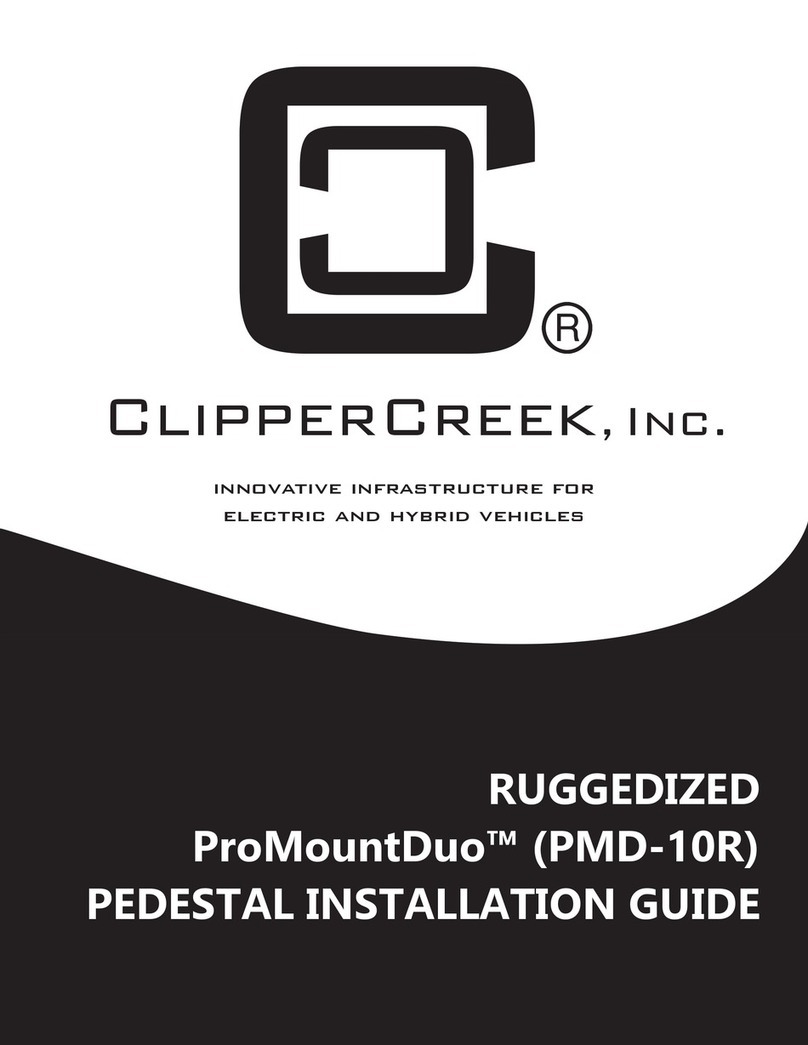ClipperCreek HCS User manual

ClipperCreek, Inc.
Innovative Infrastructure for
Electric and Hybrid Vehicles
• • • • • • •
Model HCS
User Manual

HCS User Manual
2
To view the latest version of this manual please visit
clippercreek.com/installation-manuals
HCS User Manual, Version 17, June 2020
Copyright © 2020 ClipperCreek, Inc.
All rights reserved. Printed in the USA.
Manual Number: 7004-0014-B
PLEASE NOTE
This user manual includes the latest information at the time of
printing. ClipperCreek, Inc. reserves the right to make changes to
this product without further notice. Changes or modications to this
product by other than an authorized service facility may void the
product warranty.
Contact a Customer Service Representative with any questions about
the use of this product. (877) 694-4194
WARNING: This product can expose you
to chemicals, including Carbon Black, which
is known to the State of California to cause
cancer. For more information go to:
www.P65Warnings.ca.gov
ADVERTENCIA: Este producto puede
exponerte a químicos, incluso Negro
Carbón, que se conocido por el Estado de
California como causante de cáncer. Para
más información visite:
www.P65Warnings.ca.gov
AVERTISSEMENT: Ce produit peut vous
exposer à des agents chimiques, y compris
Noir Carbone, identiés par l’État de
Californie comme pouvant causer le cancer.
Pour de plus amples informations, prière de
consulter: www.P65Warnings.ca.gov

HCS User Manual
3
CONTENTS
IMPORTANT SAFETY INSTRUCTIONS...............................................5
Instructions Pertaining to a Risk of Fire or Electric Shock 6
Additional Safety Instructions 12
FCC INFORMATION...............................................................................14
OPERATION..............................................................................................15
The HCS Front Panel 16
INSTALLATION - SERVICE CONNECTIONS....................................17
MOUNTING PROCEDURES ..................................................................25
HCS EVSE Mounting for Hollow-Wall Construction 26
HCS EVSE Mounting for Solid-Wall Construction 27
MOUNTING THE
SAE J1772
CONNECTOR HOLSTER ...................28
CHARGE CABLE WRAP GUIDELINES ..............................................30
WIRING INSTRUCTIONS (Hardwired HCS) ......................................31
RECEPTACLE INSTRUCTIONS (Plug-In HCS) .................................33
GROUNDING INSTRUCTIONS.............................................................34
HCS Hardwired EVSE Grounding 34
HCS Plug-In EVSE Grounding 34
USING THE PADLOCK...........................................................................35
MOVING & STORAGE INSTRUCTIONS............................................36
OPTIONAL FEATURES ..........................................................................37
MAINTENANCE ......................................................................................38
CUSTOMER SUPPORT...........................................................................39
SPECIFICATIONS....................................................................................40
WARRANTY INFORMATION (3 Year Standard) ................................42
WARRANTY INFORMATION (5 Year Ruggedized) ............................43

HCS User Manual
4
ILLUSTRATIONS
Figures
1. HCS Front Panel............................................................................................16
2. 220/240V Single Phase .................................................................................21
3. 208V 3-Phase, Wye-Connected.....................................................................21
4. 240V 3-Phase, Delta-Connected, with Center-Tap on One Leg....................22
5. Mounting the HCS to a Hollow-Wall............................................................26
6. Mounting the HCS to a Solid-Wall ...............................................................27
7. Mounting the SAE J1772 Connector Holster Using the Exterior
Wood Screws and Washers............................................................................29
8. Drape the Charge Cable Loosely Around the HCS Enclosure...................... 30
9. Wiring the HCS in a Junction Box ................................................................31
10. Preferred Orientation of the NEMA Receptacles Below the Plug-in HCS ... 33
11. Locking the SAE J1772 Connector with Padlock Included..........................35
12. Charge Connector Secured with Padlock which Cannot be Removed
from Vehicle without Key .............................................................................35
13. Padlock Used in Combination with Connector Holster After Charging .......35
Tables
1. Front Panel LED Information........................................................................16
2. Service Connections for Standard & Ruggedized HCS ................................17

HCS User Manual
5
IMPORTANT SAFETY INSTRUCTIONS
Carefully read these instructions and the charging instructions in
your vehicle owner’s handbook before charging your electric vehicle.
The following symbols may be found in this manual or on labels
afxed to the Electric Vehicle Supply Equipment (EVSE):
NOTE:
This means pay particular attention. Notes contain
helpful suggestions.
REMARQUE: Cela signie accorder une attention
particulière. Les remarques contiennent des suggestions
utiles.
NOTA: Esto signica que debe prestar especial atención.
Las notas contienen sugerencias útiles.
CAUTION: This symbol means be careful. There is
potential to do something that may result in damage to the
equipment.
ATTENTION: Ce symbole signie être prudent. Vous
êtes capable de faire quelque chose qui pourrait causer des
dommages à l’équipement.
ATENCIÓN: Este símbolo signica tener cuidado. Usted
es capaz de hacer algo que puede resultar en daños al
equipo.
WARNING: This symbol means danger. You are in a
situation that could cause bodily injury. Before you work
on any electrical equipment, be aware of the hazards
involved with electrical circuitry and standard practices for
preventing accidents.
AVERTISSEMENT: Ce symbole signie un danger.
Vous êtes dans une situation qui pourrait causer des
blessures corporelles. Avant de travailler sur un équipement
électrique, être conscient des dangers présentés par les
circuits électriques et les pratiques courantes de prévention
des accidents.

HCS User Manual
6
Instructions Pertaining to a Risk of Fire or Electric Shock
When using the HCS, basic electrical safety precautions should be
followed:
• Use this EVSE to charge electric vehicles equipped with an
SAE J1772™charge port only. Consult the vehicle’s owner
manual to determine if the vehicle is equipped with the
correct charge port.
• Make certain the EVSE SAE J1772 charge cable is
positioned so it will not be stepped on, tripped over, or
otherwise subjected to damage or stress.
• This product contains no user serviceable parts. Consult
the Customer Support section in this manual for service
information. Do not attempt to repair or service the EVSE
yourself.
• Do not operate your EVSE if it or the SAE J1772 charge
cable is physically open, cracked, frayed, or otherwise
visibly damaged. Contact a Service Representative for
service immediately. Consult the Customer Support
section in this manual for information on the Service
Representative in your area.
• Not for use in commercial garages where a
COMMERCIAL GARAGE is dened as a facility (or
portion thereof) used for the repair of internal combustion
vehicles in which the area may be classied due to
ammable vapors being present (such as from gasoline).
ADVERTENCIA: Este símbolo signica peligro. Está en
una situación que podría lesionarse. Antes de trabajar en
cualquier equipo eléctrico, debe estar consciente de los
riesgos relacionados con los circuitos eléctricos y practicas
estándares de prevención de accidentes.

HCS User Manual
7
• Do not place ngers inside of the coupler end of the
SAE J1772 charge cable.
• Do not allow children to operate this device. Adult
supervision is mandatory when children are in proximity to
an EVSE that is in use.
Additional Instructions for Plug-In HCS Congurations
•
240V plugs are specically designed for occasional
relocation, such as moving from one home to another home
.
•
For personal safety, the circuit breaker MUST be turned off
prior to plugging in AND/OR unplugging 240V appliances
(including this EVSE).
•
A dedicated NEMA outlet (receptacle) is highly
recommended. NEMA outlets wear out over time
particularly when repeated insertion and removal of NEMA
plugs occur. Check the receptacle to be sure it is not worn. A
worn receptacle can cause the plug connection to overheat
and become a re hazard. Do not use a plug that gets
excessively hot. It is recommended that plug-in EVSE
remain plugged in.
• Have an electrician
verify all wiring to the outlet is correct
and in compliance with local code requirements before
connecting the EVSE.
•
Do Not use this EVSE with an extension cord or wall plug
adapter. Plug this EVSE directly into the
receptacle
.
•
Ensure that the EVSE is mounted to the wall or placed on a
support so it does not hang from the
receptacle
.
Receptacle
s
are not designed to support the weight of the EVSE.

HCS User Manual
8
Instructions se Rapportant à un Risque d’Incendie ou de
Choc Électrique
Lorsque l’utilisation de la HCS, précautions fondamentale de
sécurité électrique doivent être suivies:
• Utilisez cette station de recharge pour charger les véhicules
électriques équipés d’un SAE J1772™ port de recharge
seulement. Consultez le manuel du propriétaire du véhicule
an de déterminer si le véhicule est équipé d’un correcte
port de recharge.
• Assurez-vous que le SAE J1772 câble de recharge sur la
station de recharge est positionné de telle sorte qu’il ne sera
pas piétiné, accroché plus de, ou autrement endommagé ou
de subir le stress.
• Ce produit ne contient aucune pièce réparable par
l’utilisateur. Consultez la section Support à la Clientèle
dans ce manuel pour obtenir des informations de service.
N’essayez pas de réparer ou d’entretenir la station de
recharge vous-même.
• Ne faites pas fonctionner votre station ou le câble de
recharge si elles sont physiquement ouverte, ssuré,
efloché, ou autrement visiblement endommagé. Contactez
votre représentant du service pour service immédiatement.
Consultez la section Support à la clientèle dans ce manuel
pour obtenir des informations sur le représentant du service
dans votre région.
• Ne pas utiliser dans les garages commerciaux où un garage
commercial est déni comme une installation (ou une
partie) utilisé pour la réparation de véhicules à combustion
interne dans lequel la zone peut être classée en raison
de vapeurs inammables étant présents (Tels que de
l’essence.)
• Ne posez pas les doigts à l’intérieur de l’extrémité du
SAE J1772 coupleur du câble de recharge.

HCS User Manual
9
• Ne pas laisser les enfants utiliser cet appareil. Supervision
d’un adulte est obligatoire lorsque des enfants sont à
proximité d’une station de recharge qui est en cours
d’utilisation.
Instructions supplémentaires pour les congurations HCS
enchables
• Les prises de 240V sont spécialement conçues pour les
relocalisations occasionnelles, tel que le déménagement
d’une maison à une autre.
• Pour des raisons de sécurité, le disjoncteur DOIT être
désactivé avant de brancher ET/OU débrancher les appareils
de 240V (dont cet EVSE).
• Une sortie (réceptacle) NEMA dédiée est fortement
recommandée. Les réceptacle NEMA s’usent avec le temps,
en particulier lorsque l’insertion et le retrait des prises NEMA
sont répétés. Vériez le réceptacle pour vous assurer qu’elle
n’est pas usée. Une réceptacle usée peut provoquer une
surchauffe du connecteur de raccordement et constituer un
risque d’incendie. Ne pas utiliser de prise qui deviendrait
excessivement chaude.
Il est recommandé que la prise de
l’EVSE reste branchée.
• Faites vérier par un électricien que tout le câblage de
réceptacle
soit correctement effectué et conforme aux
exigences de la réglementation locale avant de raccorder
l’EVSE.
• Ne pas utiliser cet EVSE avec une rallonge ou adaptateur
de prise murale. Branchez cet EVSE directement dans le
réceptacle
.
• S’assurer que l’EVSE est xé au mur ou placé sur un
support an qu’il ne soit pas suspendu à l’installation
électrique. Le
réceptacle
n’est pas conçue pour supporter le
poids de l’EVSE.

HCS User Manual
10
Instrucciones relacionadas con un riesgo de incendio o
descarga eléctrica
Al utilizar el HCS, se deben seguir las siguientes precauciones
básicas de seguridad eléctrica:
• Utilice este EVSE para cargar vehículos eléctricos
equipados con un puerto de carga SAE J1772™únicamente.
Consulte el manual del propietario del vehículo para
determinar si el vehículo está equipado con el puerto de
carga correcto.
• Asegúrese de que el cable de carga del EVSE SAE J1772
esté colocado de manera que no sea pisado, ni cause
tropiezos, ni se someta a daños o tensiones.
• Este producto no contiene partes reparables por el usuario.
Consulte la sección de Atención al Cliente en este manual
para obtener información de servicio. No intente reparar o
reparar el EVSE usted mismo.
• No opere su EVSE si éste o el cable de carga SAE J1772
están físicamente abiertos, agrietados, deshilachados o
dañados de otra manera. Póngase en contacto con un
Representante de Servicio Técnico para su reparación.
Consulte la sección de Atención al Cliente en este manual
para obtener información sobre el Representante de
Servicio Técnico en su área.
• Este dispositivo no es para uso en garajes comerciales,
en el que un GARAJE COMERCIAL se dene como
una instalación (o parte de la misma) utilizada para la
reparación de vehículos de combustión interna, en los
que el área puede ser clasicada debido a la presencia de
vapores inamables (como los de la gasolina).
• No coloque los dedos dentro del extremo del acoplador del
cable de carga SAE J1772.
• No permita que los niños operen este dispositivo. La
supervisión de un adulto es obligatoria cuando haya niños
que estén cerca de un EVSE que está en uso.

HCS User Manual
11
Instrucciones adicionales para conguraciones de HCS
enchufables
• Los tomacorrientes de 240V están especícamente
diseñados para reubicaciones ocasionales, como la
mudanza de una casa a otra.
• Por su seguridad personal, el interruptor de circuito
DEBE estar apagado antes de enchufar Y/O desenchufar
dispositivos de 240V (incluyendo este dispositivo EVSE).
• Se recomienda encarecidamente una salida (receptáculo)
NEMA dedicada. El receptáculo NEMA se desgastan con
el tiempo, especialmente cuando se produce una conexión y
desconexión repetidas de los enchufes NEMA. Verique el
receptáculo para asegurarse de que no esté desgastada. Un
receptáculo desgastado puede causar que la conexión del
enchufe se sobrecaliente y sea riesgo de incendio. No use
un enchufe que se caliente demasiado. Se recomienda que
el EVSE enchufable permanezca enchufado.
• Haga que un electricista verique que todo el cableado del
tomacorriente sea correcto y que cumpla con los requisitos
del código local antes de conectar el EVSE.
• No Use este EVSE con un cable de extensión o adaptador
de enchufe de pared. Conecte este EVSE directamente a la
toma el receptáculo.
• Asegúrese de que el EVSE esté montado en la pared
o colocado sobre un soporte para que no cuelgue del
receptáculo. Los enchufes no están diseñados para soportar
el peso del EVSE.

HCS User Manual
12
Additional Safety Instructions
WARNING: Turn off power to the EVSE at the circuit
breaker panel before moving, servicing or cleaning the unit.
AVERTISSEMENT: Couper l’alimentation de l’EVSE au
niveau du panneau de disjoncteurs avant de déplacer,
d’effectuer la maintenance ou de nettoyer l’appareil.
ADVERTENCIA: Desconecte la alimentación del EVSE
en el panel del interruptor automático antes de mover,
reparar o limpiar la unidad.
WARNING: Always turn off input power to the EVSE
at the circuit breaker panel prior to plugging into or
unplugging from a wall socket.
AVERTISSEMENT: Toujours éteindre la puissance
d’entrée du EVSE sur le panneau du disjoncteur avant de
brancher ou de débrancher un socket mur.
ADVERTENCIA: Apague siempre la alimentación de
entrada al EVSE en el panel del interruptor de circuito,
antes de enchufarlo o desenchufarlo de un tomacorriente.
NOTE: VENTILATION - Some electric vehicles require
an external ventilation system to prevent the accumulation
of hazardous or explosive gases when charging indoors.
Consult the vehicle owner’s manual to determine if your
vehicle requires ventilation during indoor charging.
REMARQUE: VENTILATION - Certains véhicules
électriques nécessitent un système de ventilation externe
pour éviter l’accumulation de gaz explosifs ou dangereux
lors de la charge à l’intérieur. Consultez le manuel du
propriétaire du véhicule pour déterminer si votre véhicule
nécessite une ventilation quand le recharge en salle.
NOTA: VENTILACIÓN - Algunos vehículos eléctricos
requieren un sistema de ventilación externo para evitar
la acumulación de gases peligrosos o explosivos, al ser

HCS User Manual
13
cargados en interiores. Consulte el manual del propietario del
vehículo para determinar si su vehículo requiere ventilación
durante la carga en interiores.
NOTE: Vehicles which conform to the SAE J1772
standard for communication can inform the charge station
that they require an exhaust fan. The HCS is not equipped
to control ventilation fans. Do not charge the vehicle with
the HCS if ventilation is required.
REMARQUE: Véhicules qui sont conformes à la norme
SAE J1772
de communication peuvent informer la station
de recharge qu’ils nécessitent un ventilateur d’extraction.
Le HCS n’est pas équipé pour contrôler les ventilateurs. Ne
chargez pas le véhicule avec les HCS si la ventilation est
nécessaire.
NOTA: Los vehículos que cumplan con el estándar de
comunicación
SAE J1772
pueden informar que su EVSE
requieren un extractor de aire. El HCS no está equipado para
controlar ventiladores. No cargue el vehículo con el HCS si
se requiere ventilación.
CAUTION: DO NOT CHARGE a vehicle indoors if it
requires ventilation. Contact a Service Representative for
information.
ATTENTION: NE PAS RECHARGER un véhicule à
l’intérieur si il nécessite une ventilation. Contactez votre
représentant de service pour plus d’informations.
ATENCIÓN: NO RECARGUE un vehículo en interiores
si requiere ventilación. Póngase en contacto con su
Representante de Servicio Técnico para obtener más
información.
Save these instructions for future reference.
Conservez ces instructions pour référence future.
Guarde estas instrucciones para referencias futuras.

HCS User Manual
14
FCC INFORMATION
This device complies with Part 15 of the FCC rules. Operation
is subject to the following two conditions: (1) This device may
not cause harmful interference, and (2) This device must accept
any interference received, including interference that may cause
undesired operation.
This product has been designed to protect against Radio Frequency
Interference (RFI). However, there are some instances where high
powered radio signals or nearby RF-producing equipment (such as
digital phones, RF communications equipment, etc.) could affect
operation.
If interference to the EVSE is suspected, the following steps should
be taken before consulting a ClipperCreek®Sales or Service
Representative for assistance:
1. Reorient or relocate nearby electrical appliances or
equipment during charging.
2. Turn off nearby electrical appliances or equipment
during charging.
CAUTION: Changes or modications to this product
by other than an authorized service facility may void
FCC compliance.
ATTENTION: Modications apportées à ce produit par
qui conque autre qu’un centre de service autorisé peut
annuler la conformité FCC.
ATENCIÓN: Cambios o modicaciones a este product por
otros que no sean un centro de servicio autorizado pueden
anular el cumplimiento con la FCC.

HCS User Manual
15
OPERATION
The HCS EVSE is a compact wall or pedestal-mounted EVSE
that provides the Plug-in Hybrid or Battery Electric Vehicle
(together Plug-In Electric Vehicles, or “PEV”) user with a safe
and manageable link between the power grid and the PEV. Both
hardwired HCS and plug-in HCS versions are available.
Simply unwrap the SAE J1772 charge cable and plug the connector
rmly into the vehicle’s charge port.
Normally, the vehicle will immediately request a charge using a
special communication line in the cable. Within a few seconds the
Green “Charging” light on the face of the HCS will turn on and the
charging cycle will begin. After an average driving day the vehicle
battery pack will require several hours to recharge completely.
Charging overnight is the most convenient way to maintain healthy
batteries and ensure the vehicle’s full range will be available for
the next day.
When the vehicle has stopped charging the Green “Charging” light
on the HCS will turn off. To remove the connector head once a
charge cycle has completed (or to interrupt a charge in progress)
press and hold down the latch release lever on the connector handle
then unplug the connector from the vehicle charge port.

HCS User Manual
16
The HCS Front Panel
The front panel on the HCS has four
indicator lights, as shown in Figure 1.
POWER (Amber), indicates that
power is available to the HCS.
CHARGING (Green), indicates that
the vehicle is requesting a charge and
AC power is currently applied to the
vehicle.
POWER FAULT (Red), indicates
that the HCS is not wired correctly.
The problem can be due to improper
grounding or a missing Earth Ground.
The wiring should be examined by a
qualied electrician.
CHARGING FAULT (Red), indicates
that the HCS is unable to communicate
with the vehicle correctly, or a safety
fault condition has been detected by
the unit.
Figure 1: HCS Front
Panel
Table 1: Front Panel LED Information
No power to EVSE. Check
circuit breaker.
Not plugged into the EV or the
EV is not ready to charge.
Charging enabled, power is
applied to the vehicle.
Improper grounding or ground is
not present.
Problem with EV communications.
Disconnect and restart.
EV ground fault trip. Check
vehicle connection.
Internal EVSE fault.
Call for service.
1 off off off off
2 ON off off off
3 ON ON off off
4 ON off off
5 ON off off
6 ON off off blinking
7 ON off blinking blinking
ON - not
blinking
ON - not
blinking
Amber
Power
LED
Green
Charging
LED
Red
Charging
Fault LED Fault Condition
#Red
Power
Fault LED

HCS User Manual
17
HCS-15 Hardwired 15A
HCS-20 Hardwired 20A
HCS-20R (Ruggedized) Hardwired 20A
HCS-25 Hardwired 25A
HCS-30 Hardwired 30A
HCS-30R (Ruggedized) Hardwired 30A
HCS-40 Hardwired 40A
HCS-40P NEMA 6-50R 40A/50A
HCS-40P NEMA 14-50R 40A/50A
HCS-40R (Ruggedized) Hardwired 40A
HCS-40PR (Ruggedized) NEMA 6-50R 40A/50A
HCS-40PR (Ruggedized) NEMA 14-50R 40A/50A
HCS-50 Hardwired 50A
HCS-50P NEMA 6-50R 50A
HCS-50P NEMA 14-50R 50A
HCS-60 Hardwired 60A
HCS-60R (Ruggedized) Hardwired 60A
HCS-80 Hardwired 80A
HCS-80R (Ruggedized) Hardwired 80A
HCS Model Connection/Receptacle Type Circuit Breaker Rating
Table 2: Service Connections for Standard & Ruggedized HCS
INSTALLATION - SERVICE CONNECTIONS
CAUTION: To reduce the risk of re, connect only to a
circuit provided with the appropriate maximum branch
circuit overcurrent protection in accordance with the
National Electrical Code, ANSI/NFPA 70 (US) or the
Canadian Electric Code C22.2 NO. 280-13 (Canada).
ATTENTION: Pour réduire le risque d’incendie, de se
connecter uniquement à un circuit fourni avec le approprié
circuit de dérivation protection maximale contre les
surintensités, en conformité avec le Code National électrique
ANSI/NFPA 70 (US) ou Code Canadien de l’électricité
C22.2 NO. 280-13 (Canada).
ATENCIÓN: Para reducir el riesgo de incendio, conecte
sólo a un circuito proporcionado con la máxima protección
adecuada contra sobre corriente del circuito derivado de
acuerdo con el Código Eléctrico Nacional, ANSI/NFPA 70
(EE.UU) o el Código Eléctrico Canadiense C22.2 NO. 280-
13 (Canadá).

HCS User Manual
18
CAUTION: This is a single-phase device. Do not connect
all three phases of a 3-phase feed! You may use any two
phases of a three phase wye-transformer feed. The
centerpoint of the three phases (usually used as Neutral)
must be grounded somewhere in the system. A Neutral
connection is not required by the HCS. Only Line 1, Line 2,
and Ground are required, as shown in Figure 3.
ATTENTION: Il s’agit d’un appareil monophasé. Ne pas
relier tous les trois phases d’une alimentation triphasée!
Vous pouvez utiliser les deux phases d’un triphasé en étoile
transformateur alimentation. Le point central des triphasé
(généralement utilisé comme Neutre) doit être mis à la terre
quelque part dans le système. Une connexion Neutre n’est
pas exigée par la HCS. Seulement ligne 1, ligne 2, et Mise à
la Terre sont nécessaires, comme le montre la Figure 3.
ATENCIÓN: Este es un dispositivo de una sola fase. ¡No
conecte las tres fases de una alimentación trifásica! Puede
utilizar cualquiera dos fases de un transformador trifásico
de alimentación “Y”. El punto central de las tres fases
(generalmente utilizado como Neutro) debe estar conectado
a tierra en algún punto del sistema. Una conexión Neutra
no es requerida por la HCS. Sólo la Línea 1, Línea 2, y la
Conexión a Tierra son necesarias, tal y como se muestra en
la Figura 3.
CAUTION: The two phases used must each measure 120V
to Neutral. Earth Ground must be connected to Neutral at
only one point, usually at the service entry breaker panel.
ATTENTION: Les deux phases utilisées doivent mesurer
chaque 120V à Neutre. Mise à la terre doit être connecté au
Neutre en un seul point, généralement à l’entrée panneau de
disjoncteurs de service.
ATENCIÓN: Las dos fases utilizadas deben cuanticar
120V a punto Neutro. La Conexión a Tierra debe conectarse
al punto Neutro en un solo punto, general-mente en la
entrada de servicio del panel de interruptores automáticos.

HCS User Manual
19
CAUTION: If a 240V 3-phase feed is from a Delta-
connected secondary, the leg used must have a center-tap.
That tap must be Grounded. Only the two phases on either
side of the center-tapped leg can be used. See Figure 4.
ATTENTION: Si une alimentation à triphasé 240V
provient d’un triangle connecté secondaire, la bornes utilisée
doit avoir un centretap. Que la tap doit être Mise à la Terre.
Seuls les deux phases l’une ou l’autre côté du centre tapped
brancher peut être utilisé. Voir la Figure 4 ci-dessous.
ATENCIÓN: Si una alimentación trifásica de 240V es de
conexión secundaria Delta, la pierna utilizada debe tener
una derivación central. Esa derivación debe Conectar a
Tierra. Sólo las dos fases en cualquier lado de la pierna de
derivación central pueden ser utilizadas.
Consulte la Figure 4.
CAUTION: Warranty is void if this unit is not wired
properly.
ATTENTION: La garantie est annulée si cette unité n’est
pas correctement câblé.
ATENCIÓN: La garantía se anula si esta unidad no está
cableada correctamente.
WARNING: Only a qualied electrician should perform
the installation. The installation must be performed in
accordance with all local electrical codes and ordinances.
AVERTISSEMENT: Seul un électricien qualié doit
effectuer l’installation. L’installation doit être effectuée
conformément à tous les codes électriques locaux et des
ordonnances.
ADVERTENCIA: Sólo un electricista capacitado debe
realizar la instalación. La instalación debe realizarse
conforme a todos los códigos y ordenanzas locales.

HCS User Manual
20
Only 3 wires are connected, but care must be taken that the service
transformer secondary connection is denitely known, and the
3 wires from the main circuit breaker panel are connected and
labeled correctly. Figures 2, 3, and 4show the most common
service transformer secondary wiring formats.
Notice that L1, L2, & Ground are labeled on each diagram. Those
transformer outputs correspond to the same inputs on the HCS.
Also, each of the two 3-phase diagrams shows an L3 output, which
is not used. Do not connect all three phases of a 3-phase secondary
to the HCS. This is a single-phase device.
The Neutral at the service panel must be connected to Earth
Ground somewhere in the system on any of the three connection
arrangements. Ground-fault protection is not possible unless the
Neutral (center-tap on the service transformer) is connected to an
Earth Ground. If no Ground is provided by the electrical service, a
grounding stake must be driven into the Ground nearby, following
local electrical codes. The grounding stake must be connected to
the ground bar in the main breaker panel, and Neutral connected to
Ground at that point.
WARNING: Local electrical codes must always be
followed when installing the grounding stake.
AVERTISSEMENT: Les codes électriques locaux doivent
toujours être respectées lors de l’installation du piquet de
mise à la terre.
ADVERTENCIA: Siempre se deben seguir los códigos
eléctricos locales al instalar la estaca de conexión a tierra.
Other manuals for HCS
2
Table of contents
Other ClipperCreek Batteries Charger manuals
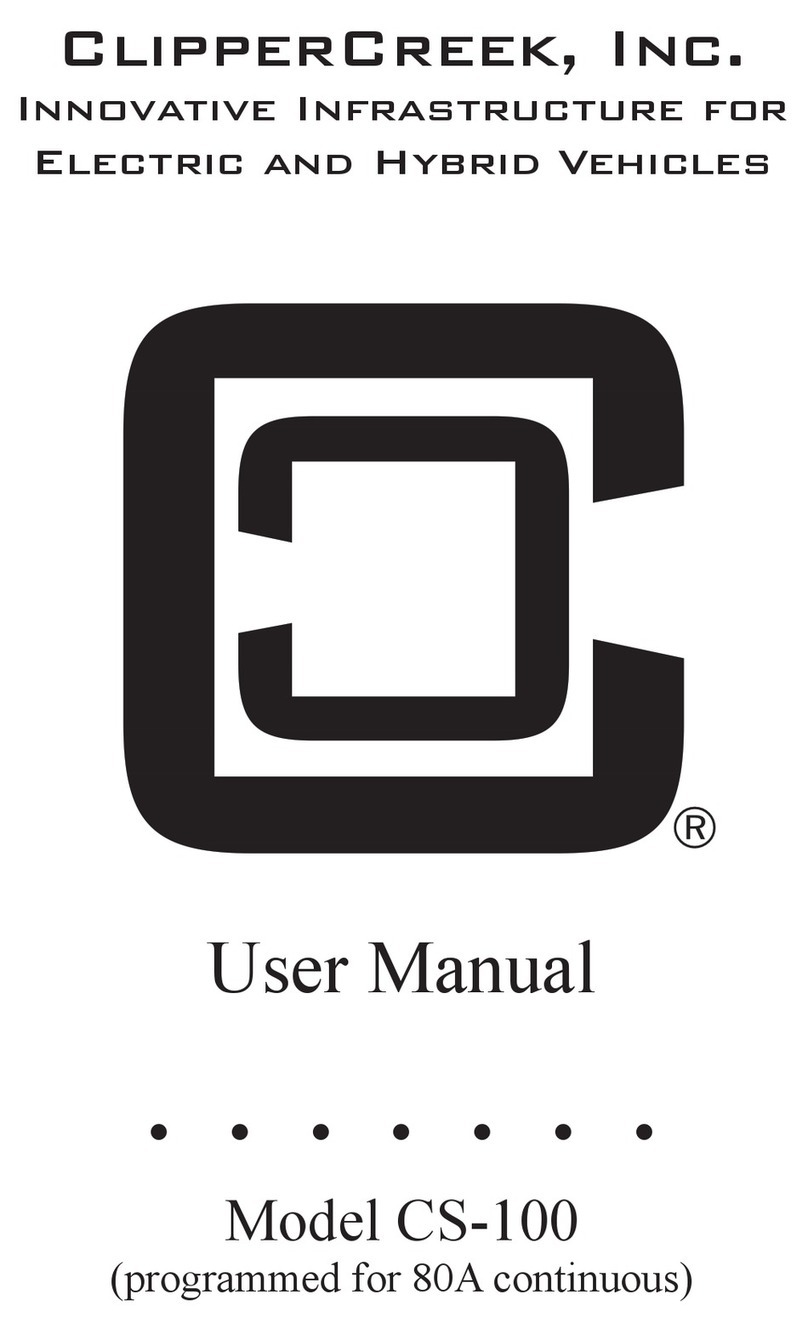
ClipperCreek
ClipperCreek CS-100 User manual
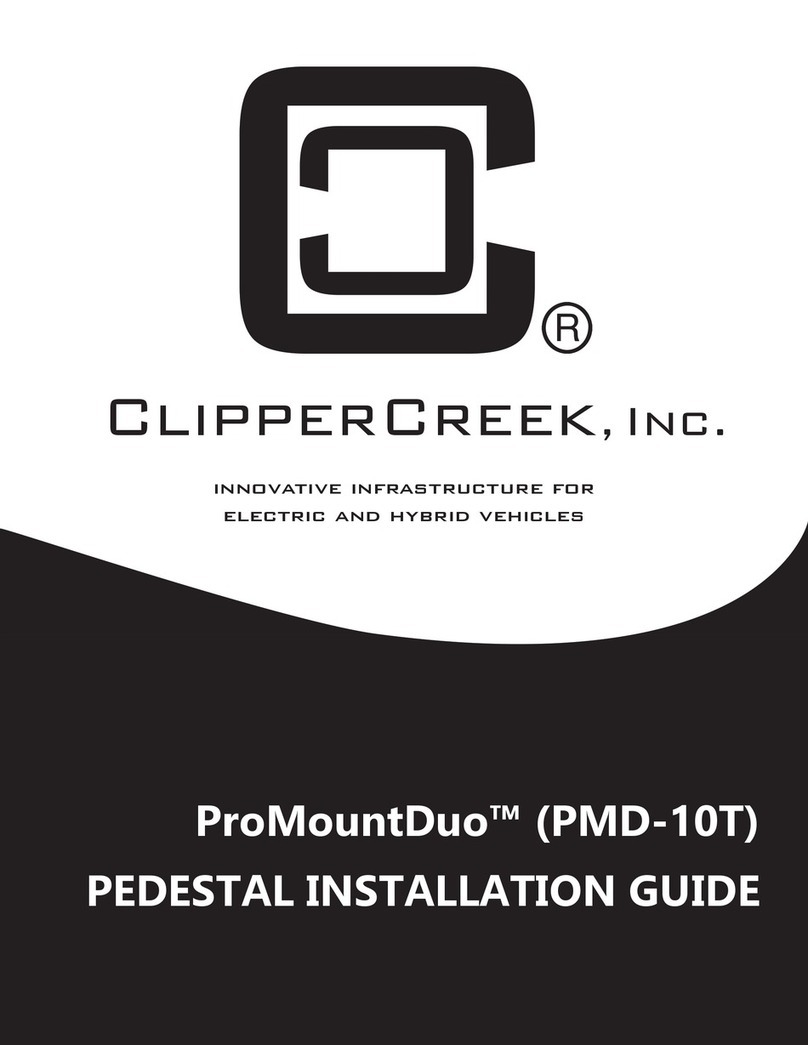
ClipperCreek
ClipperCreek ProMountDuo PMD-10T User manual
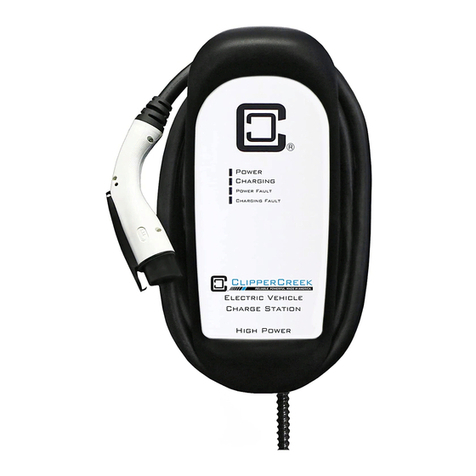
ClipperCreek
ClipperCreek HCS SERIES User manual
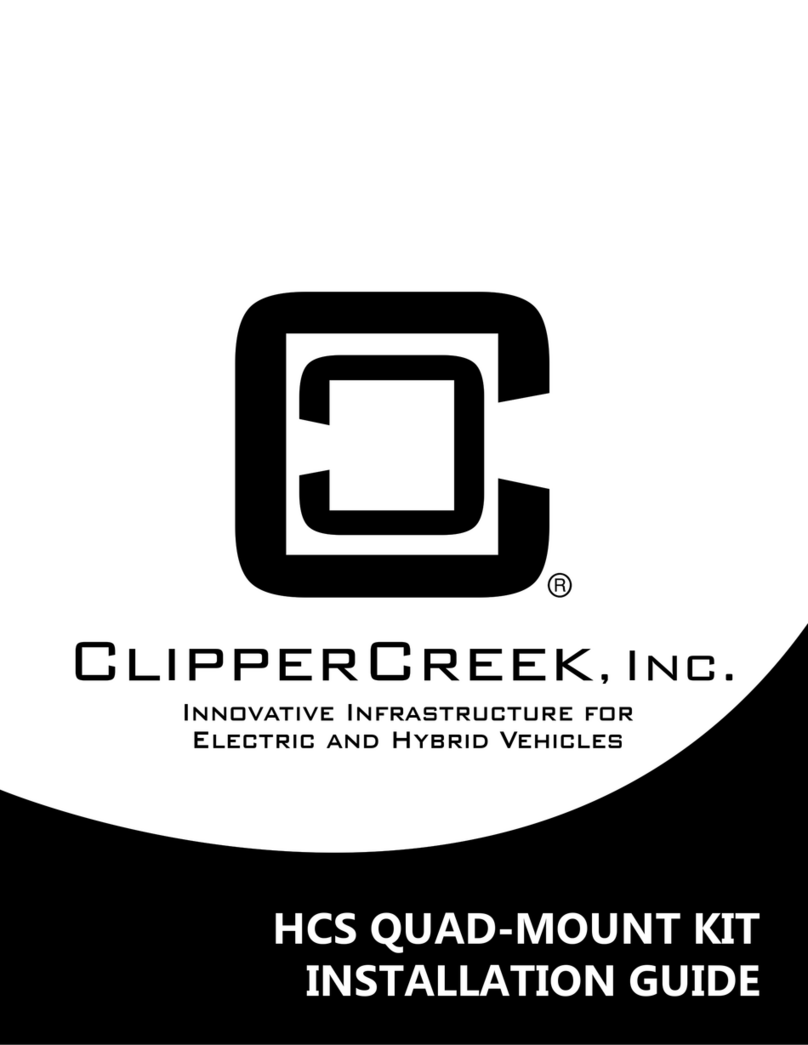
ClipperCreek
ClipperCreek HCS SERIES User manual

ClipperCreek
ClipperCreek EV Series User manual
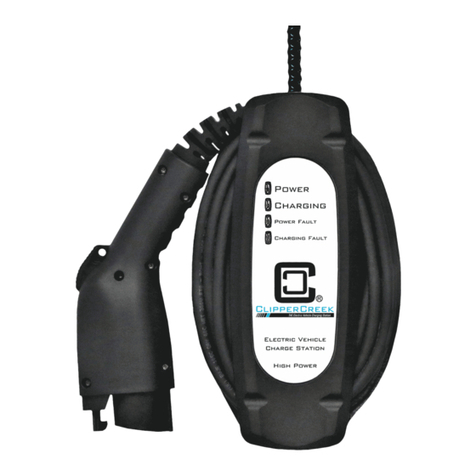
ClipperCreek
ClipperCreek LCS Series User manual
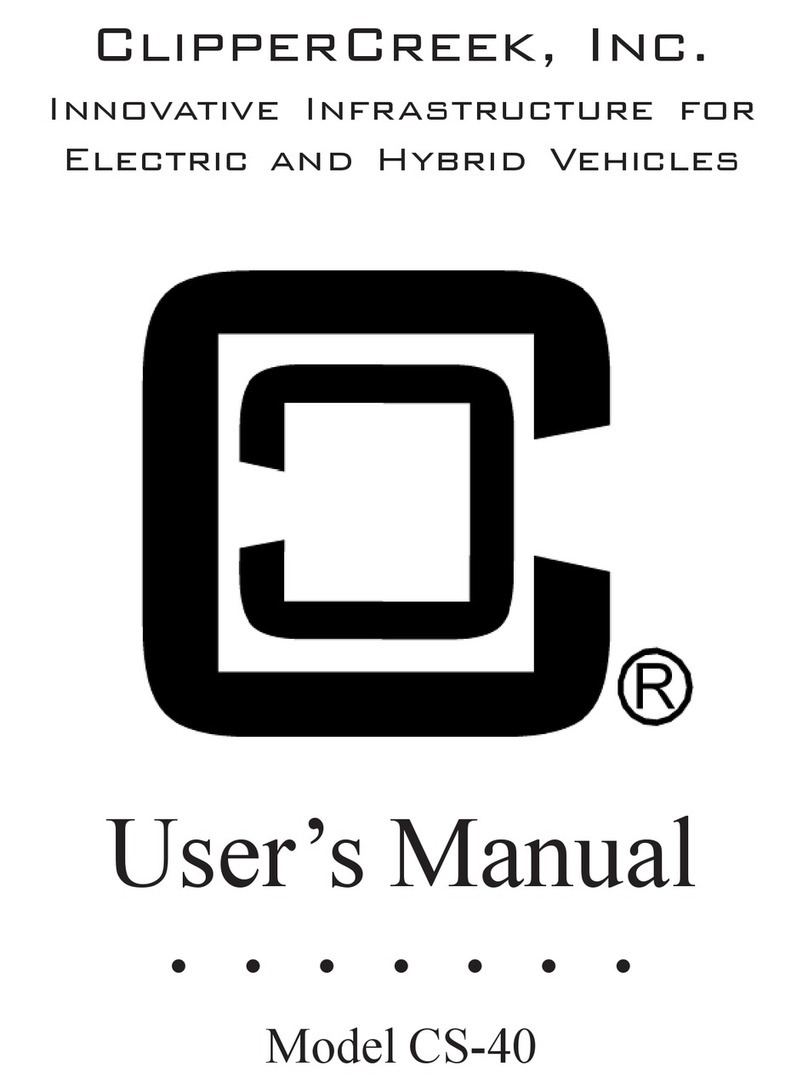
ClipperCreek
ClipperCreek CS-40 User manual
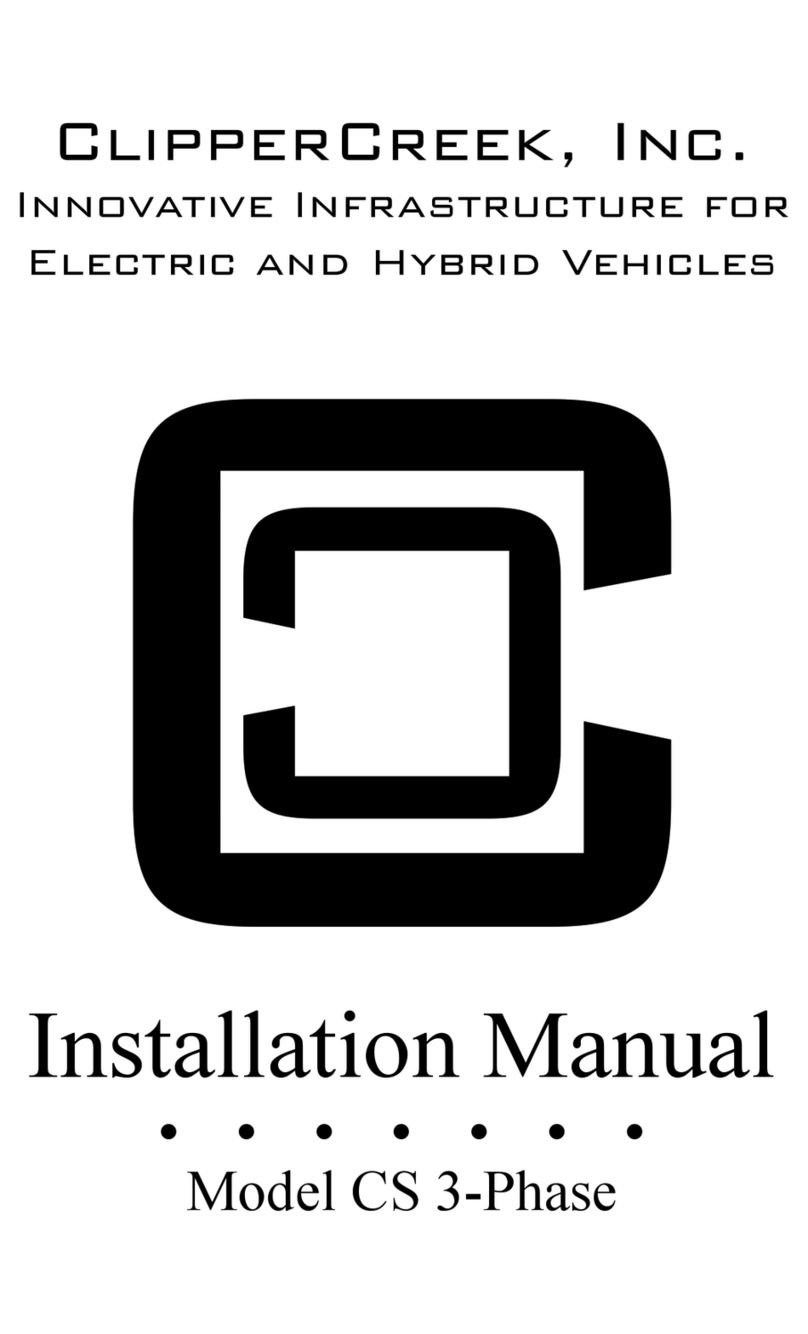
ClipperCreek
ClipperCreek CS 3-Phase User manual
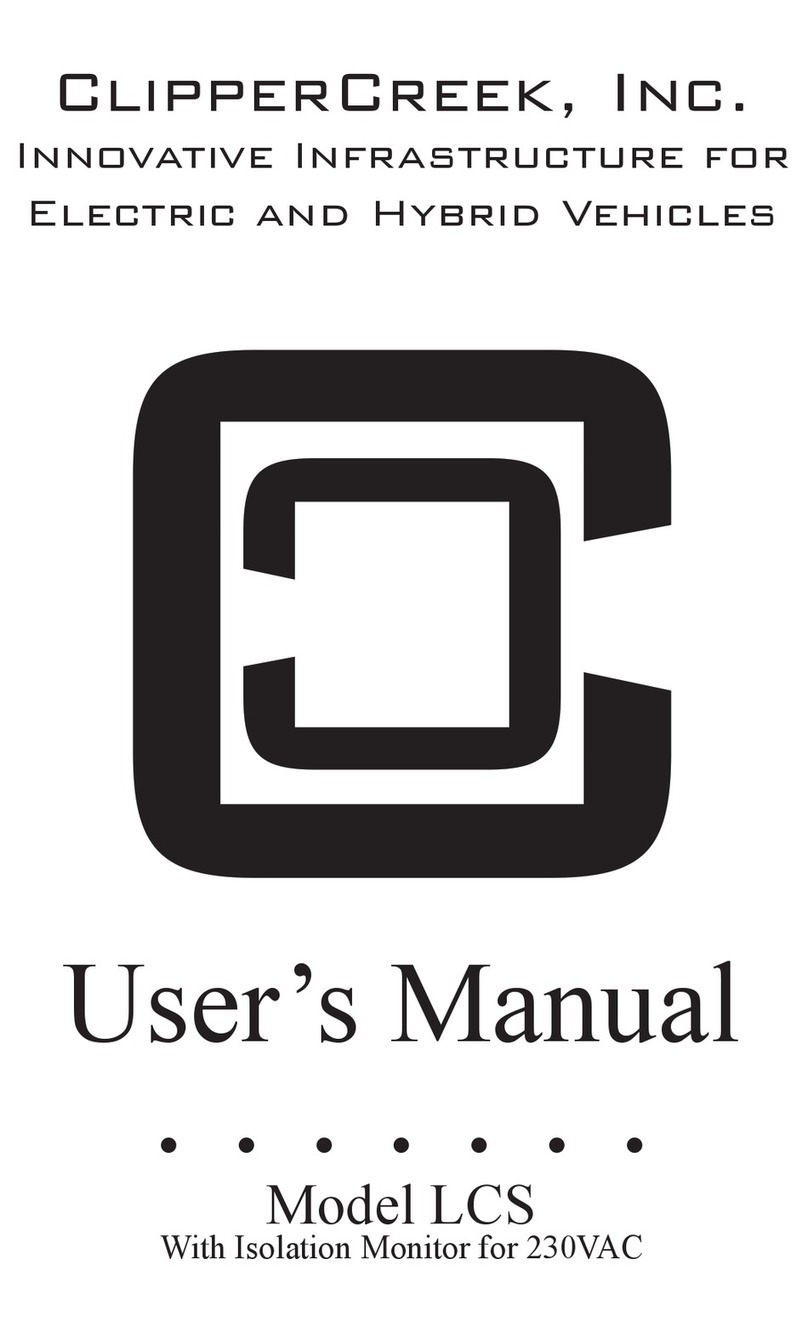
ClipperCreek
ClipperCreek LCS Series User manual

ClipperCreek
ClipperCreek HCS SERIES User manual
